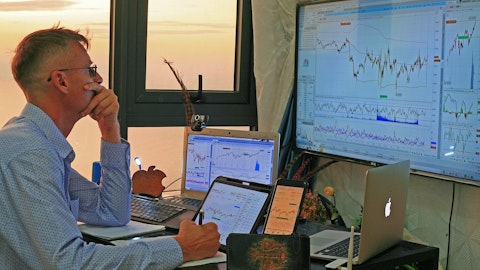Operator: Thank you. Our next question comes from the line of Andrew Nowinski of Wells Fargo. Your question, please, Andrew.
Andrew Nowinski: Thank you for taking the question. This is just a really amazing quarter again, particularly in light of some of the noise that’s been in the market. So I wanted to ask about the expanded partnerships with Dell that you announced today, and also about the — I think, the Pax8 partnership that you announced at your user conference last year. I guess first, how did both partners contribute to results in the quarter relative to your expectations? And then second, have you factored in a contribution from those partners into your F 20Y25 outlook? A – George Kurtz I’ll take the first part and I’ll turn it over to Burt. So we obviously are very excited about the Dell partnership. I’ll start with them. I talked about that earlier.
And really, we’re in the early innings. We’re winning deals, large enterprise, all the way down the SMB, taking advantage of their reach and their go-to-market motion. So still early days, and we’ve already put up some big numbers from that partnership. When we look at Pax8 and the like, again, it’s still early days, but we’ve seen tremendous success, particularly down-marketing the SMB, and what customers are looking for, even if the smaller customers are looking to solve big problems, they can’t be hit by ransomware, they can’t have an impact to their business. So it’s a perfect model for us to get to those SMBs. And it’s, like I said, early days, but tremendous results so far. Bert?
Burt Podbere: Yeah. So I think that we’re very excited about both the partnerships, both Dell and Pax8. They represent additional routes to market, but it’s still early days on both of them, as George had mentioned. But they’re one of many routes to market. We do believe that they’re going to bring deals to us. And we’re excited to have them on board as partners.
Operator: Thank you. Our next question comes from the line of Tal Liani of Bank of America. Please go ahead, Tal.
Tal Liani: Hi, guys. So we had discussions this kind of past few weeks about the pricing environment of the XDR market and the ability to offset this with add-on modules. And the question is, you touched on it, but I want to ask, do you feel the contribution of Microsoft and Cortex from Palo Alto and others, do you feel their impact on pricing of individual components of your package? And is there a story about price compression of each individual component offset by the bundle or that you just don’t see the XDR pricing pressure that Paolo Alta was talking about? Thanks.
George Kurtz: Well, again, I mean I can — I try to focus on what we’ve been able to do. And as the leader in the space, we’ve been solving problems for a long time. And when we look about — we look at the impact that ransomware and some of these very prominent breaches have had, you’re talking about hundreds of millions of dollars for companies. So to buy a platform that has the capabilities to stop breaches is really what customers are looking at. And when we think about sort of one-off modules or things of that nature, for us, we’re looking at the total package and the solution of what we put together. And of course, it’s a competitive environment, but you have to have a competitive product, you have to have the right level of innovation, and you have to have the right go-to-market motion, which we talked about in some of the prepared remarks.
So it has been competitive. It has — will be competitive. But at the end of the day, what we’re finding is that customers want the right outcome. And we’ve seen the free is not free, and we see that good enough is not good enough. And I think customers are smart enough to realize the difference between price and total cost. And that’s what we’ve been able to show with every dollar spent on CrowdStrike is a $6 return on their investment. And we’re going to continue to deliver value and outcomes for customers.
Operator: Thank you. Our next comes from the line of Alex Henderson of Needham. Please go ahead, Alex.
Alex Henderson: Great. Thank you so much. So first thing you ever said to me, George, was that you’re a platform, not an endpoint company. I think you’ve been proving it with high alacrity over the last year. With the comments coming in about plantation. It sounds like the response that you’re having here is that the companies that are trying to do that are really just offering bundles of products, but they’re not truly integrated. You’re platform is based off of cloud native, microservices, API driven. And I think if you were to talk to the degree to which you integrate any acquisition into that platform, it would be radically different than what we’re hearing or seeing from some of the other players. So can you talk about why the microservice cloud-native architecture in a single platform integrated upfront is the way to go and how hard it is for companies that are trying to disparate packages into a platform that wasn’t designed as a platform from the get-go because I think ultimately, that’s the key differentiator here.
And I would think that with the acquisition of flow, you’ll be able to integrate it much more rapidly because it’s API-driven because it’s microservice based. Can you talk to that?
George Kurtz: Yes. Sure, I can. Thanks, Alex. It’s a great . And I do remember our early conversations finally, and you’re absolutely right about being the platform for cybersecurity when I started the company. So when we think about architecture, architecture does matter and really what we’ve created is a very data-centric architecture that allows us to get data at scale into our platform leverage our AI and then create the outcomes. It’s that collect once we use many. We have a single platform. Our competitors have many other platforms as they call them. We have a single agent. Our competitors have five, six, seven, eight, depending on the competitors. So when we look at our architecture, it was really designed from the beginning to solve the problems of today and the future problems.
And the result of that is ease of use, the outcome that a customer is looking for, stopping breaches and lowering the cost and future bringing what they want. I’ve — in a prior life, I’ve been involved in companies that acquired a lot of products. And I can tell you, it is near impossible to stitch all this stuff together, particularly at the agent level unless you’re very diligent about it. And I can tell you from a CrowdStrike perspective, we’ve been very diligent about our acquisitions, as you’ve seen, and thoughtful on the pricing. But also what’s important to realize is that we bought products and we really haven’t sold some of them for the better part of 18 months because we wanted to focus on the integration, things like identity. And now we see the fruits of our labor.
So it’s this focused, long-term diligent approach to our acquisitions, I think, that have helped us because we started with a very innovative cloud-native platform from the beginning.
Operator: Thank you. Our next comes from the line of Roger Boyd of GBS. Please go ahead, Roger.
Roger Boyd: Great. Thanks for taking the question. And again, congrats on a really strong end of the year. I wanted to talk about Charlotte. The customers that we’ve spoken to that were part of that early access program pretty positive on both what the product can do today as well as the pipeline and where it could go in the future? George, you said at a couple of positive stats around automation. Any updated view on your ability to monetize the Charlotte product or the time line to monetization from here? Thanks.





